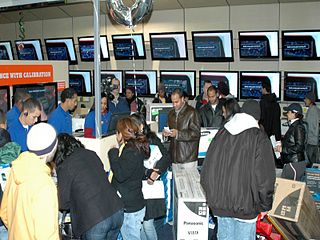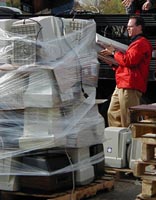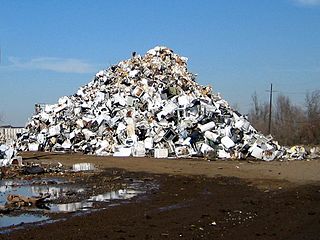Related Research Articles

Recycling is the process of converting waste materials into new materials and objects. This concept often includes the recovery of energy from waste materials. The recyclability of a material depends on its ability to reacquire the properties it had in its original state. It is an alternative to "conventional" waste disposal that can save material and help lower greenhouse gas emissions. It can also prevent the waste of potentially useful materials and reduce the consumption of fresh raw materials, reducing energy use, air pollution and water pollution.

A home appliance, also referred to as a domestic appliance, an electric appliance or a household appliance, is a machine which assists in household functions such as cooking, cleaning and food preservation.

Consumer electronics or home electronics are electronic equipment intended for everyday use, typically in private homes. Consumer electronics include devices used for entertainment, communications and recreation. These products are usually referred to as black goods due to many products being housed in black or dark casings. This term is used to distinguish them from "white goods" which are meant for housekeeping tasks, such as washing machines and refrigerators, although nowadays, these would be considered black goods, some of these being connected to the Internet. In British English, they are often called brown goods by producers and sellers. In the 2010s, this distinction is absent in large big box consumer electronics stores, which sell entertainment, communication and home office devices, light fixtures and appliances, including the bathroom type.

Post-consumer waste is a waste type produced by the end consumer of a material stream; that is, where the waste-producing use did not involve the production of another product.

Product stewardship is an approach to managing the environmental impacts of different products and materials and at different stages in their production, use and disposal. It acknowledges that those involved in producing, selling, using and disposing of products have a shared responsibility to ensure that those products or materials are managed in a way that reduces their impact, throughout their lifecycle, on the environment and on human health and safety. This approach focusses on the product itself, and everyone involved in the lifespan of the product is called upon to take up responsibility to reduce its environmental, health, and safety impacts.

Extended producer responsibility (EPR) is a strategy to add all of the estimated environmental costs associated with a product throughout the product life cycle to the market price of that product, contemporarily mainly applied in the field of waste management. Such societal costs are typically externalities to market mechanisms, with a common example being the impact of cars.

Electronic waste recycling, electronics recycling, or e-waste recycling is the disassembly and separation of components and raw materials of waste electronics; when referring to specific types of e-waste, the terms like computer recycling or mobile phone recycling may be used. Like other waste streams, reuse, donation, and repair are common sustainable ways to dispose of IT waste.
An Electronic Waste Recycling Fee is a fee imposed by government on new purchases of electronic products. The fees are used to pay for the future recycling of these products, as many contain hazardous materials. Locations that have such fees include the European Union, the US State of California and the province of Ontario, Canada.

Electronic waste describes discarded electrical or electronic devices. It is also commonly known as waste electrical and electronic equipment (WEEE) or end-of-life (EOL) electronics. Used electronics which are destined for refurbishment, reuse, resale, salvage recycling through material recovery, or disposal are also considered e-waste. Informal processing of e-waste in developing countries can lead to adverse human health effects and environmental pollution. The growing consumption of electronic goods due to the Digital Revolution and innovations in science and technology, such as bitcoin, has led to a global e-waste problem and hazard. The rapid exponential increase of e-waste is due to frequent new model releases and unnecessary purchases of electrical and electronic equipment (EEE), short innovation cycles and low recycling rates, and a drop in the average life span of computers.

Sustainable Development Strategy for organizations in Canada is about the Government of Canada finding ways to develop social, financial, and environmental resources that meet the needs of the present without compromising the ability of future generations to meet their own needs in Canada. A Sustainable Development Strategy for the organization needs to be developed that establishes the Sustainable Development goals and objectives set by the Auditor General Act of Canada and provides the written policies and procedures to achieve them. Sustainable Development is based on responsible decision-making, which considers not only the economic benefits of development, but also the short-term and long-term, Canadian environment and environmental impacts.
Olympic Group is an Egyptian group of companies operating mainly in the field of domestic appliances. The main products it manufactures are washing machines, refrigerators, electric water heaters and gas cookers. It also operates in the fields of IT and real estate. It owns the licensing rights for Sony products in Egypt. Olympic Group has acquired "IDEAL", a formerly state-owned appliances giant.

Recycling in Japan, an aspect of waste management in Japan, is based on the Japanese Container and Packaging Recycling Law. Plastic, paper, PET bottles, aluminium and glass are collected and recycled. Japan's country profile in Waste Atlas shows that in 2012 Recycling Rate was 20.8%.
Waste management in Japan today emphasizes not just the efficient and sanitary collection of waste, but also reduction in waste produced and recycling of waste when possible. This has been influenced by its history, particularly periods of significant economic expansion, as well as its geography as a mountainous country with limited space for landfills. Important forms of waste disposal include incineration, recycling and, to a smaller extent, landfills and land reclamation. Although Japan has made progress since the 1990s in reducing waste produced and encouraging recycling, there is still further progress to be made in reducing reliance on incinerators and the garbage sent to landfills. Challenges also exist in the processing of electronic waste and debris left after natural disasters.

Electronic waste is a significant part of today's global, post-consumer waste stream. Efforts are being made to recycle and reduce this waste.

Mobile phone recycling describes the waste management of mobile phones, to retrieve materials used in their manufacture. Rapid technology change, low initial cost, and planned obsolescence have resulted in a fast-growing surplus, which contributes to the increasing amount of electronic waste around the globe.
Electronic waste or e-waste in China refers to electronic products that are no longer usable and are therefore dumped or recycled. China is the world's largest importer and producer of electronic waste with over 70% of all global e-waste ending up in the world's largest dumpsites. An estimated 60–80% of this e-waste is handled through illegal informal recycling processes, without the necessary safety precautions legally required by Chinese government regulations. Processing e-waste in this way directly causes serious environmental damage and permanent health risks in areas surrounding the disposal sites. While the Chinese government and the international community have taken action to regulate e-waste management, ineffective enforcement, legislative loopholes, and the pervasiveness of informal recycling have been obstacles to mitigating the consequences of e-waste.

Electronic waste in New Zealand is an environmental issue being addressed by community and government initiatives.

Appliance recycling is the process of dismantling scrapped home appliances to recover their parts or materials for reuse. Recycling appliances for their original or other purposes, involves disassembly, removal of hazardous components and destruction of the equipment to recover materials, generally by shredding, sorting and grading. The rate at which appliances are discarded has increased due in part to obsolescence due to technological advancement, and in part to not being designed to be repairable. The main types of appliances that are recycled are televisions, refrigerators, air conditioners, washing machines, and computers. When appliances are recycled, they can be looked upon as a valuable resources; if disposed of improperly, they can be environmentally harmful and poison ecosystems.
A take-back system or simply takeback is one of the primary channels of waste collection, especially for e-waste, besides municipal sites. Take-back is the idea that manufacturers and sellers "take back" the products that are at the end of their lives. Take-back is aimed to reduce a business' environmental impacts on the earth and also increase efficiency and lower costs for their business models. "Take-back regulations have targeted a wide array of products including packaging, batteries, automobiles, and electronics", and economic value can be found from recycling or re-manufacturing such products. "The programs benefit municipalities by lowering their overall waste disposal costs and reducing the burden on landfill sites". Although for certain companies, the take-back system is mandatory under legislation, many do it voluntarily.

Waste management in South Korea involves waste generation reduction and ensuring maximum recycling of the waste. This includes the appropriate treatment, transport, and disposal of the collected waste. South Korea's Waste Management Law was established in 1986, replacing the Environmental Protection Law (1963) and the Filth and Cleaning Law (1973). This new law aimed to reduce general waste under the waste hierarchy in South Korea. This Waste Management Law imposed a volume-based waste fee system, effective for waste produced by both household and industrial activities.
References
- 1 2 "E-waste recycling still falling short | The Japan Times". The Japan Times. Retrieved 2017-02-15.
- 1 2 "Recycling electronic waste in Japan: Better late than never | CNN Travel" . Retrieved 2017-02-15.
- ↑ Bo, Bi (2010). "Characteristics of E-waste Recycling Systems in Japan and China" (PDF). International Journal of Environmental, Chemical, Ecological, Geological and Geophysical Engineering. 4.
- ↑ Bo, Bi (2010). "Characteristics of E-waste Recycling Systems in Japan and China" (PDF). International Journal of Environmental, Chemical, Ecological, Geological and Geophysical Engineering. 4.
- ↑ Bo, Bi (2010). "Characteristics of E-waste Recycling Systems in Japan and China" (PDF). International Journal of Environmental, Chemical, Ecological, Geological and Geophysical Engineering. 4.
- 1 2 Chung, Sung-Woo. "A Comparative Study of E-waste Recycling Systems in Japan, South Korea, and Taiwan from the EPR Perspective: Implications for Developing Countries": 125–145. Archived from the original on 2017-03-05. Retrieved 2010-10-07.
{{cite journal}}: Cite journal requires|journal=(help) - ↑ "Law for Promotion of Effective Utilization of Resources". Ministry of Economy, Trade and Industry. Retrieved 3 February 2012.
- ↑ "Revised Law Requires Recycling of Additional Home Appliances". Japan for Sustainability. Retrieved 3 February 2012.
- 1 2 3 "Law for Promotion of Effective Utilization of Resources". nett21.gec.jp. Archived from the original on 2017-07-20. Retrieved 2017-02-15.
- 1 2 Bo, Bi (2010). "Characteristics of E-waste Recycling Systems in Japan and China" (PDF). International Journal of Environmental, Chemical, Ecological, Geological and Geophysical Engineering. 4.
- 1 2 3 "Law on Recycling of Specified Kinds of Home Appliances (Home Appliance Recycling Law)". nett21.gec.jp. Archived from the original on 2016-10-28. Retrieved 2017-02-24.
- 1 2 "Japan may use e-waste for 2020 medals". BBC News. 2016-08-23. Retrieved 2017-02-15.